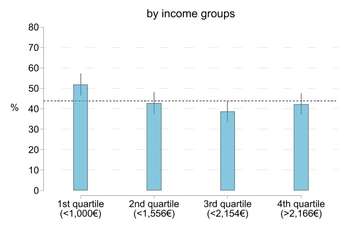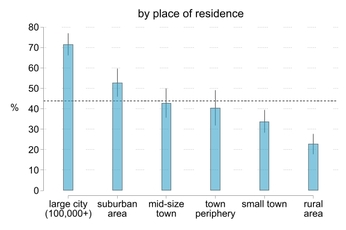Study about 9-€-Ticket
24.10.2023
A new study about the 9-Euro-Ticket published by Katrin Auspurg, Christiane Bozoyan, Claudia Schmiedeberg, Fabian Thiel und colleagues shows:
Financial relief for people with low incomes and shifts to more environmentally friendly public transport - but only where connections by bus and rail are considered to be sufficiently good.
Main results of our Germany-wide online survey in July 2022: Individuals from low-income backgrounds in particular owned the 9-Euro-Ticket, while at the same time the perceived poor quality of public transport in rural areas limited its usage. According to respondents’ self-reports, public transport substituted approximately 7% of their car rides to work when the ticket was in effect. Detailed results on the conditions for those shifts and further study findings can be found here.


Mean shares of 9-Euro-Ticket holders by group (point estimators and 95% confidence intervals) and in total (dashed reference line). The left panel shows shares across different quartiles of income (“Einkommensgruppe”), while the right panel shows shares for people residing in different regions, ranked by size from large cities (“Großstadt”) to very rural areas (“Land”). Bars above (below) the dashed line indicate above- (below-) average ownerhsip in a group, while the 95% confidence intervals indicate whether groups differ significantly from the overall mean. N = 1347 respondents.
In the summer of 2022, the 9-Euro Ticket attracted a great deal of attention: For three months, public transport could be used almost free of charge throughout Germany. With this measure, the German government reacted to price increases during the "gas crisis" and at the same time aimed at boosting public transport, which had not yet recovered from the slump in passenger numbers in the COVID-19 pandemic.
To evaluate the effectiveness of the ticket, it is necessary to understand which population groups benefitted most from the low fares and how the ticket was used. LMU researchers Prof. Dr. Katrin Auspurg, Dr. Christiane Bozoyan, Dr. Claudia Schmiedeberg, and Dr. Fabian Thiel, therefore conducted an online survey on the usage of the 9-Euro-Ticket in July 2022. [Together with Prof. Dr. Henning Best (RPTU Kaiserslautern-Landau) und Prof. Dr. Andreas Diekmann (ETH Zürich and Universität Leipzig).] They surveyed around 1300 people (a cross-section of the German population aged 18-70, recruited by an online-access panel) to find out whether they had bought the 9-Euro-Ticket in June or received it through a public transport subscription (such as a Job-Ticket), how they used the ticket, and whether they commuted to work using the ticket.
The results show clear differences between population groups: Individuals in low-income households owned the ticket particularly often, both by purchase and through a subscription; thus, the intended financial relief was achieved. At the same time, there were clear differences between urban and rural areas, as the ticket was used significantly less in rural areas, especially when public transport connections were considered to be poor.
Both dimensions are also relevant for differences in commuting behavior: Individuals with low incomes used the 9-Euro-Ticket more frequently to commute by public transport instead of by car. Regardless, commuters in rural areas were less likely to switch from car use to public transportation. Overall, respondents’ car use for commuting trips decreased by almost 7 percentage points in June 2022 as compared to the previous month, meaning that a substantial proportion of car trips to work were replaced by public transport during the validity period of the 9-Euro-Ticket.
In summary, the results imply that low public transport costs can motivate a significant proportion of the population to switch to more environmentally friendly public transport – but only if public transport connections are considered to be sufficiently good. The study clearly shows that it is not the different population composition in rural areas but the perceived lower quality of public transport which limits usage, even at very low fares.
The full publication in the Kölner Zeitschrift für Soziologie und Sozialpsychologie (in German only, sorry) is available here.

